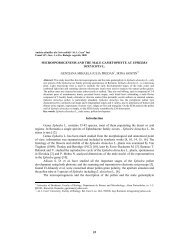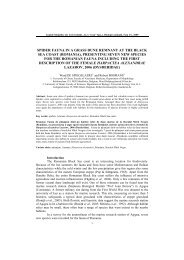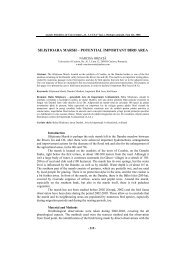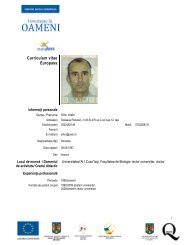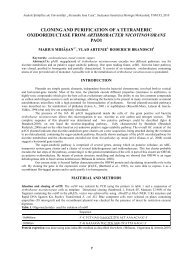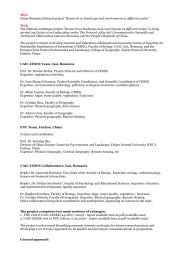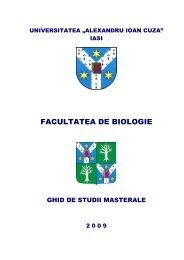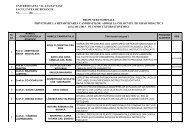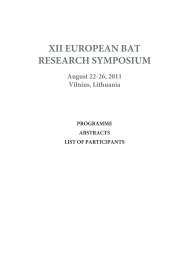Analele ştiinţifice ale Universităţii “Al - Facultatea de Biologie
Analele ştiinţifice ale Universităţii “Al - Facultatea de Biologie
Analele ştiinţifice ale Universităţii “Al - Facultatea de Biologie
You also want an ePaper? Increase the reach of your titles
YUMPU automatically turns print PDFs into web optimized ePapers that Google loves.
elements present between the rays bear mo<strong>de</strong>rately thickened, but unlignified<br />
walls, representing libriform in progress.<br />
The main root. The structure is similar to that of the lateral root, with the following<br />
peculiarities:<br />
- at the periphery there could persist a thin region (often one-layered) of cells with<br />
weak thickened and suberified walls, which results from the activity of the<br />
phellogen differentiated from a profound cortical layer (Fig. 4);<br />
- phello<strong>de</strong>rm is well represented, multi-layered, bearing big cells with mo<strong>de</strong>rately<br />
collenchymatised walls in M. arvense and M. saxosum;<br />
- the ring of secondary phloem is thicker; there are groups of sclerenchymatic<br />
elements with mo<strong>de</strong>rately thickened and lignified walls in the center, periphery<br />
(M. arvense) and in the endo<strong>de</strong>rmis (M. cristatum);<br />
- the secondary xylem massive is quite thick, bearing a big quantity of libriform<br />
with numerous vessels of various diameter, irregularly dispersed (Fig. 5). In M.<br />
sylvaticum the central xylem massive presents an axial region with vessels<br />
separated by lignified parenchyma and an outer thicker region where the vessels<br />
are separated by numerous libriform elements, with strongly thickened and<br />
mo<strong>de</strong>rately lignified walls (Fig. 6). In M. bihariense, in the central part of the<br />
xylem massive there are two compact groups of smaller vessels, with strongly<br />
lignified walls, which represent rests of the primary xylem and tell us that the stel<br />
from the primary structure is of diarchic type (Fig. 7).<br />
Haustoria appear on the lateral roots and penetrate the root of other species (which<br />
belong to the same Melampyrum species or to other species). As a general form, the<br />
haustoria are spherical, with nodule-like profile.<br />
The root which forms haustoria has an asymmetric shape (at least regarding the<br />
central cylin<strong>de</strong>r) and the general structure is modified: the parenchymatic tissues (cortical,<br />
phloemic) prevail; the xylemic and phloemic tissues are weak <strong>de</strong>veloped (Fig. 8 and 9).<br />
Some cross sections of the main root display a longitudinal section of the haustoria,<br />
so, a cordon of tracheidal elements surroun<strong>de</strong>d by cellulosed parenchymatic cells could be<br />
distinguished (Fig. 10 and 11).<br />
The longitudinal section through the haustoria of M. cristatum evi<strong>de</strong>nces the direct<br />
contact between the cordon of xylem vessels of the haustoria and the xylem tissue of the<br />
main root. Xylem vessels bear mostly screw thickenings, surroun<strong>de</strong>d by long parenchyma<br />
cells, with weak thickened, but cellulosed walls. In M. sylvaticum the primary endo<strong>de</strong>rmis<br />
of the main root elongates in the haustoria. At the limit between the two partners (parasite<br />
and host), the cells of the haustoria present suberified and weak thickened walls; at the<br />
periphery of the haustoria almost all the cells are elongated, suchlike the root hairs, playing<br />
an important role in affixing on host’s root and penetrating it.<br />
The stem. In the superior part, the cross section has quadrate-rectangular profile,<br />
with roun<strong>de</strong>d angles (M. arvense, M. bihariense, M. cristatum, M. sylvaticum) or a<br />
hexagonal profile with roun<strong>de</strong>d angles and numerous hairs on two opposite si<strong>de</strong>s (M.<br />
saxosum) (Fig.12).<br />
In all 5 species, epi<strong>de</strong>rmis presents isodiametric cells of various dimensions, with<br />
the internal and external walls thicker than the others, the last one being covered by a thin<br />
cuticle; here and there, some multicellular unilayered protective hairs are present, bearing a<br />
narrowed terminal cell and very short multicellular secretory hairs, with unicellular pedicle<br />
7



